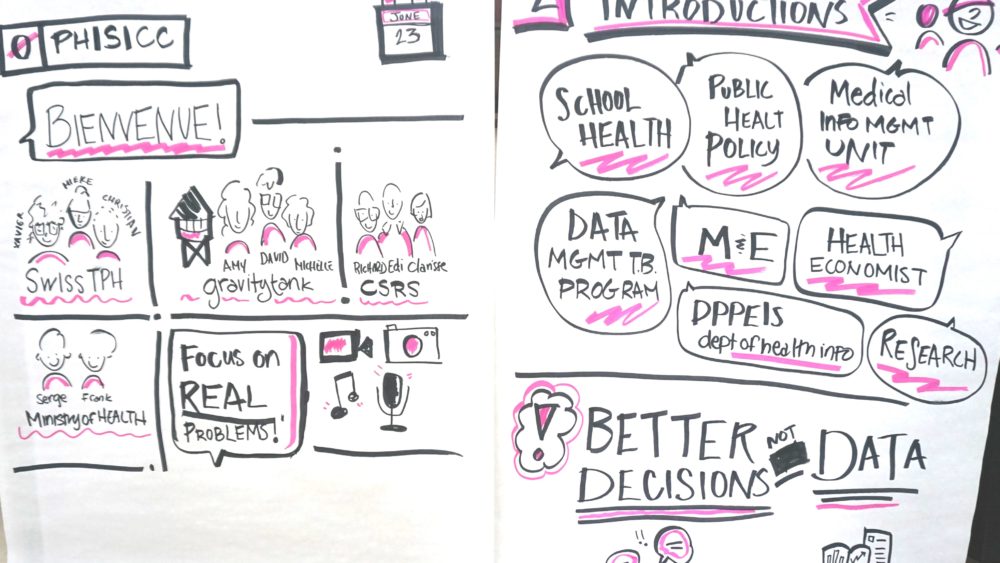Bringing evidence on health information systems into policy and practice in Nigeria : A prospective research case study to overcome barriers implementing change.
A project supported by Leading House Africa.
Overview
Paper based Health information System in Comprehensive Care (PHISICC) is an operational research project that has introduced innovative, user-friendly recording and reporting tools, i.e. registers and tallying/reporting sheets. The design of the tools was carried out using an innovative method of human centred design processes that brought together designers, health workers and public health researchers. Its overall goal was to improve health service provision and performance of frontline health workers through the new tools and its features.
We will build upon the 5-year research project PHISICC: in Nigeria, the paper-based new recording and reporting tools (the PHISICC tools) were assessed in a randomised controlled trial in Yala, a Local Government Authority (LGA) of Cross River State (CRS); the next step now is to implement these new recording and recording tools in new areas. Engagement with stakeholders is key. This project will do this, showing how change can actually take place.
The project will build the skillset in our research partners, especially their ability to grasp and apply implementation research methods and the emerging area of participatory research in health. The project will also develop case studies that can be used in teaching MSc and PhD modules in the local institutions of our African applicants.
Our research questions are :
- What is the readiness of managers and policy makers in the uptake of health systems
innovations, including barriers and facilitators ?
- Which are effective processes by which innovations can actually be transferred into policy and practice ?
Project outline
In order to improve the clinical capacity of health workers and at the same time reduce their workload, PHISICC sought to redesign the health information system (HIS) tools health workers use in remote, rural areas. PHISICC was informed by a series of systematic reviews and used a Human Centred Design approach to produce the paper-based intervention, which has been tested in three randomised controlled trials in three African countries (Côte d’Ivoire, Mozambique and Nigeria). As in any research, at the end of the project, the outstanding issue is “how can innovative solutions from research make it to the everyday life of the health system?” Thus, in this research we seek to understand the readiness of managers and policy makers in the uptake of health system innovations, such as PHISICC, and what can facilitate its uptake. Secondly, we want to understand what are the most effective processes by which innovations such as this can actually be transferred into everyday work life in the healthcare system.
We plan to carry out this work in two LGAs in Nigeria: one LGA in Cross River (not Yala) and one in Ebonyi State. This will cover about 120 health facilities, the basic level for receiving care closest to where people reside in rural area.
Objectives
- To identify formal and informal stakeholders (including traditional and religious leaders) who play a role in taking on board health system innovations to policy and practice.
- To establish the readiness of managers and policy makers in the uptake of a health system innovations, namely the PHISICC tools; and to identify barriers and facilitators.
- To actually implement the PHISICC tools in two LGAs, covering approximately 120 governmental primary health care facilities and describe the implementation process.
To answer our research questions, we plan the following:
- to scope the literature on evidence about policy uptake of interventions,
- to interview about 15 stakeholders, such as managers, policymakers, health workers, community leaders, who are closely involved in the ecosystem of promoting and providing healthcare in these areas.
- A two stages stakeholders engagement process to define what components of the research innovations can be actually implemented into the day to day workspace of health workers in the field.
Training of health workers in the use of the agreed PHISICC tools will be carried out and they will then subsequently use the tools in their facility. We expect that at the end we will provide robust evidence on a showcase about how to move findings from the research field to policy and practice.
The findings will contribute to recommendations towards how to get end-users such as health workers, policymakers and other stakeholders to adopt innovations from policy to practice.
Stages of the research work
Workstream 1 : Overview of systematic reviews to be abreast of all the forms of interventions to improve policy uptake. During this stage, we will also commence engagement with stakeholders and policymakers at both state and national levels, to enable us to deploy the tools.
Workstream 2 : Identification of stakeholders’ influence for policy change using desk review of documents and interviews. The end product will be a clear understanding and strategy of how to engage with stakeholders to facilitate and implement change.
Workstream 3 : Identification and training of health workers on the use of the PHISICC tools. The level of introduction and scope will depend on the specific decisions reached in each LGA. It could involve the whole PHISICC suite or only specific tools.
Workstream 4 :
(i) Continuous engagement with policymakers identified in workstreams 1 and 2 using the participatory research methods that we have identified a priori for improving policy uptake.
(ii) Support to decision-making and communication.



Comments are closed.